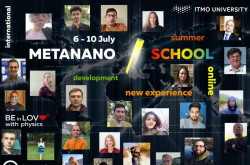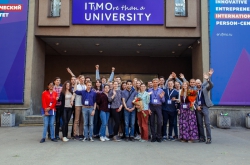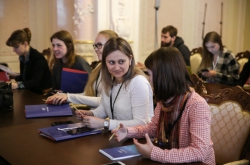Isabelle Straude, Chief Researcher at the University of Jena
 Isabelle Straude
Isabelle Straude
I work in the field of nanophotonics; my team focuses on researching high-index dielectric nanoparticles. For a long time already, scientists from all over the world have been interested in research on plasmonic nanostructures that take the form of metal particles, in which particular types of oscillations occur when free electrons interact with the metal's electric field. Yet, using such nanostructures is problematic, as they actively absorb light, heat up, and lose energy. Our approach is using high-index dielectric nanoparticles instead of metal ones. Those don’t lose much energy; also, the researcher has the opportunity to control their interaction with light. By using metamaterials, it is possible to create specific waveguides - upon passing them, light changes its properties, thus allowing to change the properties of different optical components - lenses, holograms and such. For instance, this can be used for creating lenses with adjustable focus. This technology can have a wide range of uses, especially when one has to work with light waves of specific wavelength. Point is, the performance of particular dielectric materials depends on the wavelength of the wave they interact with, so when it changes, the metamaterial no longer works as intended. For now, we do fundamental research in this field. I spoke of these dielectric metasurfaces during my lecture for the Nanophotonics and Metamaterials International Doctoral Summer School, whereto I were invited by its organizers with whom we collaborate. Such events offer a great chance to meet new colleagues, forge new partnerships and exchange ideas with other scientists. Also, I spent a lot of time speaking to the students - it seems that they are really interested in their work, there were lots of questions.
Phillip Guche, PhD student at the Free University of Berlin
 Phillip Guche
Phillip Guche
I am a theoretician; I focus on mathematical calculations and modeling. My field has to do with studying chiral nanostructures - objects with no bilateral symmetry. Such objects interact with light in a specific manner, which leads to particular optical phenomena. I describe such phenomena. Taking mind of molecules' chirality is most important when producing medications, so my research can really help optimize the process. As of now, many teams do research in this field, which is believed to be most promising. Here at the Summer School I wanted to meet people who do corresponding experimental research and learn what results have. Also, it was most interesting to listen to reports of professional scientists - thanks to them, we could all get a complete review on what now happens in the field of nanophotonics. I can't say I've learned something completely new, yet I got the chance to learn certain things in more detail. Personally, I do not aim to become a professor, I would prefer doing research and engineering work for some company.
Fedor Benimetskiy, Master's student at the Novosibirsk State University
 Fedor Benimetskiy
Fedor Benimetskiy
I came to the Nanophotonics and Metamaterials International Doctoral Summer School to meet new people and learn something new. While we are novice scientists, our outlook is quite narrow - we have to work on our theses and have little time to learn other things. Such Summer Schools are a great opportunity to learn revelant information on particular fields from the very source - the scientists who work in them. For instance, Andrei Lavrinenko gave a great review on what’s being done in his field. Reports presented here are of a really high level, as well as those who come to listen to them. For any student, this is a great experience. Another good thing about such summer schools is that young people gather here, so you feel more at ease to ask your questions - it’s different from professional conferences where you're surrounded by Doctors of Science. I do research on "nanolasers" - nanostructures that can be used as light sources; those can be used in medicine. There are two types of nanostructures used for diagnostics and treatment. For diagnostics, they use fluorescent tags that are delivered to a tumor, so that one can trace it by the light they emit. For treatment, metal nanoparticles are delivered into the tumor, and then heated so as to destroy the adjacent cells. What we work on is in a way combining the two. Soon, we're publishing an article on that in Nature Communications; my work is to describe the nanoparticles we use.
Daria Sulgacheva, PhD student for M. V. Lomonosov Moscow State University
 Daria Sulgacheva
Daria Sulgacheva
I've been to science conferences in St. Petersburg several times, but it's the first time I came for so long, as this Summer School took almost a week. The program was most intense, also, I spent a lot of time communicating with other participants. At such events you can learn what happens in the scientific community without having to read articles. For me, that is very important, as my English is yet not good enough for reading serious scientific papers. What is more, the Summer School is a great way to learn about research in adjacent fields of science. My research has to do with spintronics, magnonics and plasmonics and focus on increasing the quality of optical and magnetic recording. I work on optical generation of magnetostatic spin waves in magnetic dielectric films using plasmonic nanoantennas. Yes, that sounds like some strange set of words for many people. As of now, such waves are generated using magnetic fields of high emission frequencies, but to apply them, one has to generate waves without having to connect additional devices. Also, wavelength is an issue, and this is where we can apply nanoantennas. I do fundamental research, and many new research articles published on this subject, so my scientific advisor sometimes hurries me up.
Viktoria Ruzskaya, PhD student for the Martin Luther University of Halle-Wittenberg (Germany)
 Viktoria Ruzskaya
Viktoria Ruzskaya
This year, I took up a new topic - microresonators in silicon. Silicon is a really popular material amongst scientists, as there's lots of silicon on our planet, and it’s cheap. I came to the Summer School so as to gain new knowledge and conduct an experiment at one of ITMO's Laboratories as part of my own research. We've measured the luminescence of nanodiscs that have quantum dots inside. They emit light in near IR light; that can be connected with disk modes. On the current stage of research, we can consider the opportunities to control the signal and change its form. In future, it can be used to create "nanolasers" in which we will be able to control the light propagation direction. There were many people at the Summer School who work on this topic, so we had the opportunity to agree on future collaborations. To my mind, the lectures were great as well - they had great structure: the speakers started with the fundamentals, then there were the introductions, and then scientists shared their own results.
Yoakvin Faneka, PhD student for the University of Exeter (Great Britain)
 Yoakvin Faneka
Yoakvin Faneka
I chose to do my PhD in the field of nanophotonics and metamaterials, as I've always been interested in electronics and photonics. As of now, I study in the UK, though before that I studied in Spain, and my scientific advisor is from Russia. Before starting my PhD program, I won a full scholarship; what's more, my research is funded by the Oclaro private company - they develop new optical devices for transferring and storing information. My task is to develop silicon nanostructures for this goal. I came to the Nanophotonics and Metamaterials International Doctoral Summer School to get new ideas and see if I can use metamaterials for my work. I already spoke with many of the lecturers and participants, and it seems that I learned of some methods that can be of use. Also, I really like it here in St. Petersburg. It's my first time coming here, and truth be told, I was a little worried about it, as I didn't know what local people are like. Yet, it turned out to be an absolutely European city, and people here are very nice and always ready to help; also, I really like the food here.





